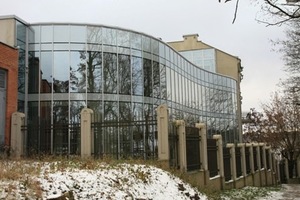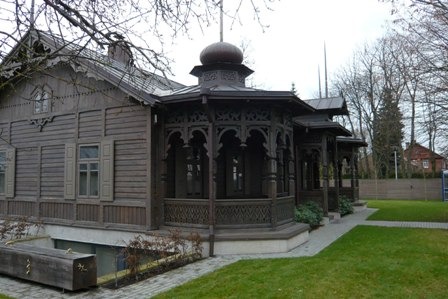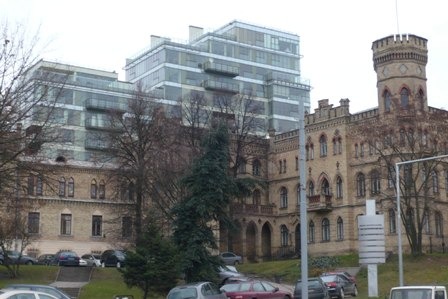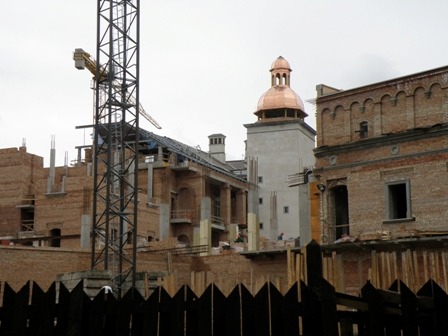NEW LITHUANIA RUINS FOUNDATIONS OF ITS VALUE RELENTLESSLY 0
According to research of LAAH,www.kamane.lt 2009 01 13
Kaunas. Reconstruction of St. Zita Society Complex
Vilnius. Reconstruction of a private dwelling-house in Poškos Str.
Vilnius. Complex Dolphin
Vilnius. The Royal Palace
In brief: Art historians value the relation of contemporary Lithuanian architecture with heritage: in December of 2008 the Lithuanian Association of Art Historians organised a survey of members “The Best and Worst Buildings of Independence Period in Historical Surroundings”.
Architecture built in the independence period changed the face of Lithuanian cities markedly. New quarters emerged, separate historical buildings and urban spaces changed. Intensive constructions did not only encourage positive changes but also gave birth to serious problems.
Radical reconstructions have destroyed originality of old buildings irreversibly, entire urban monuments are being ruined (e.g.,Vilnius Užupis, Žvėrynas sections, Kaunas New Town and Žaliakalnis).
The aim of the survey “The Best and Worst Buildings of Independence Period in Historical Surroundings” was to analyse and communicate the opinion of independent professional art and architecture historians, who are not related with specialised state heritage institutions and private design companies, about the relation of contemporary architecture with heritage.
Attention of the public should be drawn by the survey results to urgent issues of architectural-urban environment formation.
Architecture of the independence period (after the year 1990) was estimated: new buildings in historical surroundings and reconstructions of historical buildings adapted to new needs. Four examples were selected respectively: two best and two worst ones.
The wing of Vytautas Magnus University, Faculty of Theology in Kaunas, Gimnazijos Str. 7 (1998–2001, architect - Rimantė Gudienė) was recognised the best example of a new building in historical surroundings.
It is a contextual project of a large scale combining volumes of original author’s architecture and old architecture reconstructed with taste. The auditorium of 130 seats has been constructed in the new wing joining the former St. Zita’s house and the former laundry.
The contemporary building has been combined with the buildings of the first half of the 20th century by the principle of contrast: the hall of the auditorium forms a monumental façade of the internal yard divided by horizontal levels. The new volume does not dwarf the old architecture and is harmoniously matched with the sensitive surroundings of Žaliakalnis.
The private dwelling-house in Vilnius Žvėrynas section, D. Poškos Str. 61 (built in 1901; reconstructed in 2006; architects - Rimas Adomaitis, Gintautas Natkevičius, co-author Raimundas Babrauskas) was recognised the best example of reconstruction.
A wooden villa decorated abundantly by complicated carvings (the former house of an orthodox priest) was renovated with care preserving the initial shape and adapting it successfully to new needs. A cellar has been constructed; however, the novelty does not harm the authentic view. The upper forms and details of the house have been restored carefully according to the initial view.
The house is valued not only because of professional reconstruction but also for the important position of the customer and architect to bring up the aesthetic and historical value of wooden city architecture of the end of the 19th – beginning of the 20th century.
The residential complex with commercial premises “Dolphin” in Vilnius, A. Juozapavičiaus Str. 3 (2003–2005, arch. Kęstutis Pempė, Lijana Jančytė, Eglė Kirdulienė; customer Inreal) was recognised the worst example of new architecture in the historical background.
The massive complex intruded into the urbanistically complicated surroundings near the Green Bridge aggressively. The multi-apartment house in A. Juozapavičiaus Str. is valued as a symbolic example of the painful situation typical to other cities as well – the disproportional volume has dwarfed the headquarters of the Lithuanian Union of Architects located in the former Raduškevičiai Palace of expressive style of historicism.
The Royal Palace in Vilnius was recognised the worst example of reconstruction. It is an example of imaginative non-historical thinking (construction term 2002–2009; project manager and chief architect Rimas Grigas, project scientific manager – Napaleonas Kitkauskas; builder Public Enterprise Vilnius Direction of Castles; contractor – consortium TŪB Vilniaus Papėdė headed by Aloyzas Bertašius).
The Royal Palace is being constructed in the most strictly regulated territory of the old town of Vilnius without sufficient iconographic and historical material, without preparing the detailed plan, without grounding the adaptation and usage conception, using modern materials and equipment (“gothic” vaults are made from reinforced concrete).
It is a typical example of sham architecture in order to restore the illusion of a Renaissance building. The new building blankets the view of Gediminas hill and competes drastically with the building of Vilnius Cathedral.
The implementation of this project is against valid principles of preserving historical places and their adaptation to present-day needs, it harms the image of Lithuania as a modern and European country.












